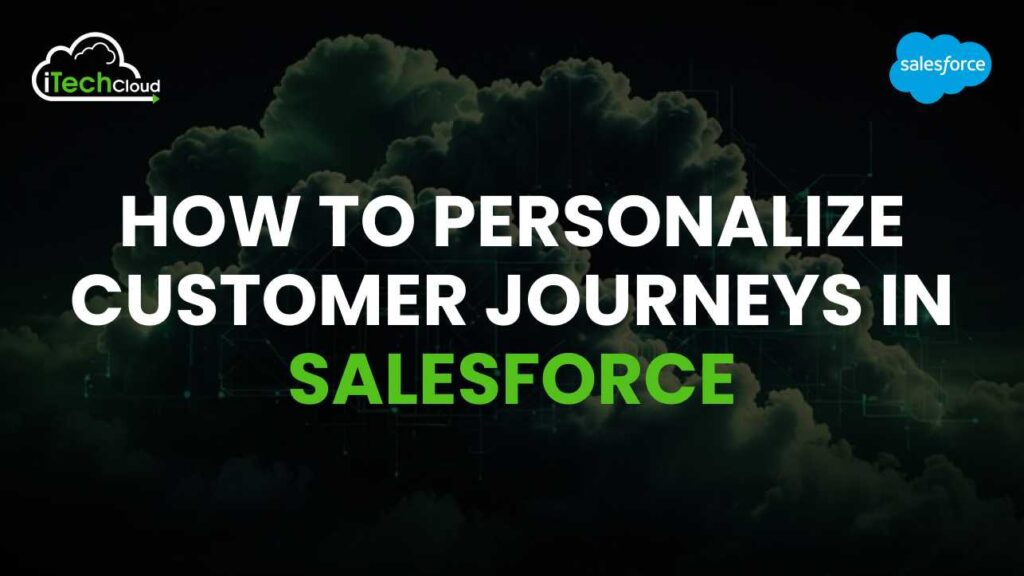How to Personalize Customer Journeys in Salesforce

Personalizing customer journeys in Salesforce involves tailoring interactions and experiences to meet the specific needs, preferences, and behaviors of individual customers.
Here’s a summary of how to achieve this using Salesforce’s various tools and features:
1. Understanding Customer Data: Customer Journeys in Salesforce
- Data Collection: Gather comprehensive customer data across touchpoints. Salesforce enables this through Sales Cloud, Service Cloud, and Marketing Cloud. Data points include demographics, past purchases, engagement history, and preferences.
- Data Segmentation: Use Salesforce’s AI-powered tools like Einstein to segment customers based on similar behaviors or characteristics, ensuring targeted communication.
2. Salesforce Marketing Cloud
- Journey Builder: Create personalized, multi-channel customer journeys. Use triggers based on customer actions (like email opens or purchases) to move customers through different journey stages.
- Content Personalization: Use dynamic content features in Marketing Cloud to tailor email, SMS, or social media content based on customer segments or real-time data.
3. Integrate AI with Einstein
- Einstein Predictions: Predict future behavior like churn risk or product affinity to tailor messages accordingly.
- Einstein Recommendations: Use AI-driven recommendations for upselling or cross-selling based on past purchases or browsing behavior.
4. Implement Customer 360
- Unified View: Salesforce Customer 360 provides a unified view of each customer by integrating data across all Salesforce products. This ensures all departments (sales, service, marketing) are aligned in their communication and strategies.
- Personalized Interactions: With a complete customer profile, every interaction is informed, contextual, and relevant, from email campaigns to customer service calls.
5. Use Salesforce Pardot for B2B Personalization
- Lead Nurturing: Automate and personalize the lead nurturing process based on prospect behavior. For example, send targeted content based on the specific white papers they download or webinars they attend.
- Lead Scoring: Score leads dynamically to prioritize and personalize follow-ups based on engagement levels.
Table of Contents
6. Personalization with Salesforce CDP (Customer Data Platform)
- Data Unification: Combine first-party data across various touchpoints to build a complete, real-time customer profile.
- Real-time Personalization: Deliver personalized experiences based on real-time data, such as recommending a product on a website based on recent activity.
7. Personalization Across Channels
- Omni-channel Engagement: Use Salesforce to personalize interactions across email, SMS, social media, websites, and even offline channels. For instance, tailor in-store promotions based on online behavior.
- Consistent Messaging: Ensure consistent and personalized messaging across all channels using Salesforce’s unified platform.
8. Track and Optimize Journeys
- Analytics: Use Salesforce’s robust analytics tools to measure the effectiveness of personalized journeys. Track metrics like engagement rates, conversion rates, and customer satisfaction scores.
- A/B Testing: Regularly test different personalized strategies and refine them based on performance data.
9. Privacy and Trust
- Data Governance: Ensure all personalized strategies comply with data protection regulations like GDPR or CCPA. Salesforce provides tools to manage customer consent and data usage preferences.
- Transparency: Be transparent with customers about how their data is used to enhance their experiences.
10. Continuous Improvement
- Feedback Loops: Incorporate customer feedback into your personalization strategies. Use surveys, social listening, and direct feedback to refine customer journeys continuously.
- Adapt to Changes: Stay agile and adapt your personalization strategies based on changes in customer behavior, market trends, or new Salesforce features.
Conclusion:
Personalizing customer journeys in Salesforce involves a strategic blend of data-driven insights, AI-powered tools, and omni-channel engagement. By utilizing tools like Salesforce Marketing Cloud, Journey Builder, and Einstein AI, businesses can create tailored experiences that resonate with individual customers. Salesforce’s Customer 360 and CDP ensure a unified view of each customer, enabling consistent, relevant interactions across all touchpoints. Additionally, tools like Pardot enhance B2B personalization through lead nurturing and scoring, while real-time personalization is made possible with Salesforce CDP.
To optimize these journeys, businesses must track performance using Salesforce’s analytics and A/B testing, while maintaining data privacy and trust through robust governance. Continuous improvement based on customer feedback and changing behaviors is essential for staying relevant.
Ultimately, effective personalization in Salesforce not only enhances customer satisfaction and loyalty but also drives business growth by delivering the right message to the right person at the right time.

